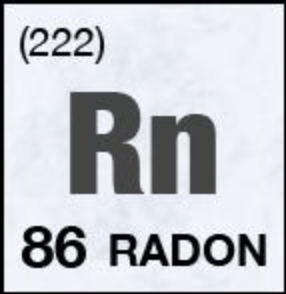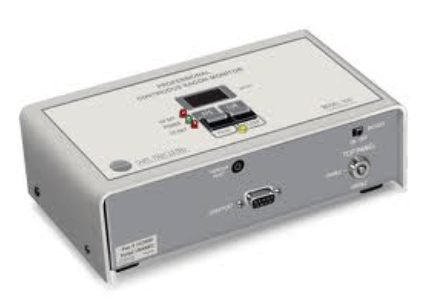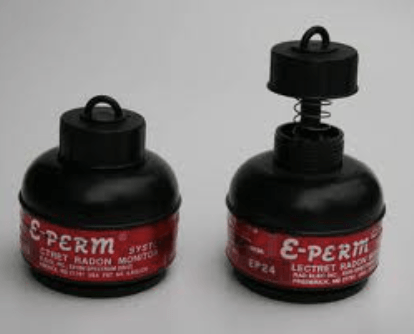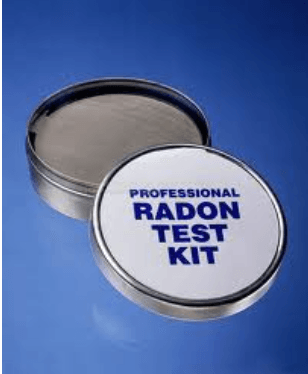Hazard or Hype?
January is National Radon Awareness Month, so this is a great time to discuss what radon is, why it can be hazardous and how you can determine if your home has high radon levels.
From my experience as a home inspector, radon is an often confused subject among many real estate agents, home buyers and homeowners. I hear many agents tell their clients not to worry about radon or that radon is not real. Well, radon is indeed a real thing — it’s number 86 on the periodic table of elements. Am I bringing back memories of high school chemistry?

According to the U.S. Environmental Protection Agency (EPA), radon exposure is the second leading cause of lung cancer after smoking. Approximately 20,000 Americans die from radon-related lung cancer annually. The use of tobacco substantially multiplies the risk of radon-related lung cancer (by a factor of approximately 15 times).
Radon is a radioactive gas born from the normal break-down of uranium and other elements in the ground. Radon has no smell or taste, and you can’t tell its concentration in your home without a radon test. As a normal part of nature, substances within the earth rise to the surface; and radon gas is one of them. Some amount of radon is present in almost all homes; and according to the EPA, south central PA has the highest indoor average radon concentration. This conclusion is based upon many years of real data collection from licensed radon testers across the country.
How does radon get into my home?
The EPA recommends that every home be tested for radon. The vast majority of radon emanates from soil. Radon can enter the home in various ways. The most common way is through cracks and voids in foundation walls and floors, and to a lesser degree via well water and building materials. We all know warm air rises, so radon gas is also affected by indoor ventilation such as the stack effect.
The stack effect relates to warm air rising within a structure and the need for replacement air to take its place from beneath. The stack effect can be driven by the type of heating in the home, direction and force of exterior winds, open vents and flues and other combustion appliances. The space beneath a basement is most often the source of much of the replacement air. Since this space is in direct contact with the earth and radon most commonly emanates from the soil, this is the common transport mechanism.
Some real estate agents and homeowners are erroneously under the belief that radon levels can’t be high in a city home or if the home is built on a concrete slab or over a crawl space (no basement). While a high radon level is often in a house with a basement, this is not always the case. The same goes for the home’s age as high radon concentrations have been measured in 200 year old homes and brand new homes. All homes should be tested for radon.
What on earth is a “picoCurie”?
Radon concentrations are most commonly measured in picoCuries (pronounced peek’o-cure-ees) per Liter of air and abbreviated as pCi/L. A ‘Curie’ is a unit of radiation measurement named for Pierre and Marie Curie. Radiation is all around us. Much of it naturally occurs from sources such as space and inside our bodies, but also comes from many other places such as radon and medicinal soures (like X-rays). There is much more radiation exposure from radon and X-rays than from nuclear power plants, cosmic rays, etc. Since breathing is the easiest way for a gas to enter the body, lung cancer is the primary result of radiation exposure from radon.
Any level of radon (and radiation) can be a health hazard, but the U.S. EPA has compiled a considerable amount of data relating to radiation exposure and results on the body. The EPA has set 4.0 pCi/L as the Recommended Action Level for radon. If a radon test result is 4.0 pCi/L or higher, radon remediation is recommended by the EPA. Radon levels below 4.0pCi/L can also be unsafe, but reduction methods in some cases can be difficult under this level. Even if a radon test shows low concentrations, simple things like remodeling a home, weather-stripping doors or windows, reglazing windows, replacing HVAC equipment or nearby blasting can change or create new entry points of radon into the home or affect internal drafting. In cases where one of the above is done, performing another radon test is recommended.
What is used to measure radon?

Continuous Radon Monitor (photo courtesy of Sun Nuclear Corp.)

ePerm (Photo courtesy of Rad Elec. Inc.)

Activated Charcoal Test Kit
Radon concentrations can be tested using several different devices, including continuous radon (CR) monitors, e-Perms (Electret), activated charcoal (AC). These are the three most popular testing devices. Each has its own advantages and disadvantages although the continuous monitor is the most common technology used for professional radon testing during a home transaction.
Since radon concentrations depend on air movement to properly and reliably test for radon in a structure, the EPA has come up with specific standards for testing called “closed house conditions”. These conditions must exist to help limit exterior effects and ensure reliable test results. The EPA defines “Closed House Conditions” as all of the home’s exterior doors and windows (not just basement windows) kept closed starting at least 12 hours prior to the start of a radon test. This does not mean close the windows and doors once the inspector arrives to start the radon test. Exterior doors can be opened and closed momentarily for normal entering and exiting the home during the test. Central heating or A/C systems must also be run normally beginning 24 hours prior to the test and for the test duration (thermostat set to approximately 64 to 70 degrees Fahrenheit). This helps ensure real life occupancy conditions in the home. Whole-house fans and window or wall-mounted A/C units (unless running in circulating mode) must not be operated during the radon test since they exchange air with the exterior. Chimney flue dampers should also be closed, and fireplaces should not be used during the radon test unless they are the home’s only heating source.
When the inspector arrives to drop off and retrieve the radon test, he will do his best to verify that closed house conditions have been met. The inspector will communicate with the seller or home’s occupant a day or so prior to the start of the test in order to review PA DEP (Department of Environmental Protection) radon test protocols and answer any questions. This communication is made before the radon test starts, because the radon test protocols begin before the inspector even arrives to place the radon test.
Most, if not all, certified radon testers have the seller or occupant sign a radon test agreement which explains the test criteria and is also a form of quality control. This form helps ensure that the owner or occupant understands the radon test protocols and affirms that they won’t interfere with the radon test. Should any evidence of test interference be noted, the radon test must be voided per PA DEP rules since the results cannot be relied upon for accuracy. PA DEP regulates radon testing and remediation in the Commonwealth of Pennsylvania.
The EPA has specific requirements regarding where in the home radon testing can occur. This is related to things such as proximity to windows, vents and outer walls, as well as near sources of moisture like kitchens, bathrooms and laundry rooms. The PA DEP has set protocols for professional radon testing and remediation professionals in Pennsylvania; some of the Pennsylvania protocols are more stringent than what the U.S. EPA requires. PA DEP requires that radon testing occurs in the lowest possible living level. This normally is the basement unless there is a dirt floor or the ceiling height does not allow for normal living conditions.
What if a radon test indicates a high radon level?
If the radon test result is high (4.0 pCi/L or higher), remediation (also called mitigation) can be successful in lowering the home’s radon level in most circumstances. The most common method of remediation is a sub-slab depressurization system. To put it simply, one or more holes are drilled in the foundation slab (such as the basement floor); a small amount of dirt is excavated under the slab; PVC pipe is installed with a radon fan; and this system vents to the exterior away from doors and windows. Radon fans can only be placed in an attic or exterior of the home. Radon fans cannot be installed in the home’s living space or in the basement. Since inspecting homes I have seen many improper radon system installations. The PA DEP has specific requirements about how and where radon systems can be installed, and they’ve created a standard for this type of system (the “PA Radon Mitigation Standards”). Professional radon remediation systems in Pennsylvania must be installed to these standards. The cost of a professionally installed radon remediation system in our area is normally in the $800-$1,200 range. Remediation system designs and their pricing can vary based upon the home’s layout, the initial radon test result, type of system installed, etc.
Who performs a radon test and remediation?
The PA DEP requires that all individuals performing professional radon testing or remediation be licensed by the Commonwealth. A homeowner or builder can perform radon testing and remediation in their own homes; however, a PA DEP licensed radon tester should be used for a home transaction to ensure a non-compromised test performed to PA DEP standards. Any changes to an installed radon remediation system should only be performed by a licensed radon remediator as well. Contractors (plumbers, electricians, etc.) who are not PA DEP licensed for radon remediation should never modify remediation piping or radon fans as this is against the law in PA. Minor changes to remediation pipes and fans may cause the system to not work properly or may raise the radon concentration within the home. The PA DEP updates its list of licensed testers and remediators each month. This information can be obtained from the PA DEP website; click here or call the radon hotline at 800-23-RADON.
Matthew Steger, ACI, WIN Home Inspection
Facts, opinions and information expressed in the Closing Comments Blog represent the work of the author and are believed to be accurate, but are not guaranteed. The Lancaster County Association of Realtors® is not liable for any potential errors, omissions or outdated information. If errors are noted within a post, please notify the Association. Posts represent the author’s opinion and are not necessarily the opinion of the Association.













